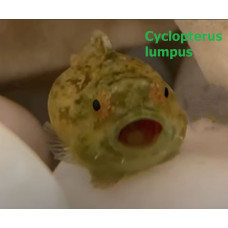From the words of Ancient Greek κύκλος 'circle' and Ancient Greek πτέρυξ 'fin'.
Cyclopteridae is a family of fishes of the order Scorpaeniformes. There are 9 genera and about 30 species. Fish with a short, fleshy body, up to 60 cm long. The first dorsal fin is often hidden under the skin. The pelvic fins are modified into a suction cup. Marine, coastal fish of the northern parts of the Atlantic and Pacific Oceans. The best known is Cyclopterus lumpus, which is found in the North Atlantic. It has a body length of up to 60 cm and a mass of up to 5.5 kg. Spawning is portioned. Lays bottom brightly colored eggs. The clutch is guarded by the male. It feeds on benthic invertebrates and fish larvae.
The maximum body length is about 60 cm. The body is short, thick, globular in shape, lacking scales, covered with bony tubercles and spines arranged in several rows. Two short dorsal fins, the first of which may be hidden under the skin (not visible at all or has the appearance of a fleshy protrusion on the back). A second dorsal fin with 8-13 soft rays and a short anal fin with 7-13 soft rays never merge with the caudal fin. The caudal fin is large with a rounded or convex posterior margin. The swim bladder is absent. Coloration varies in different species from olive-brown to gray-green-blue. Mating coloration changes during the spawning season and sexual dimorphism have been observed in many species.
Invertebrates, small crustaceans, and mollusks feed in the near-bottom layers. Pinagoras feed most of the year on the comb Beroe cucumis. In the pelagial zone, jellyfish, euphausiids and fish larvae become the main food.
They reach sexual maturity at the age of 2-4 years. They spawn closer to the shore in shallow water. Eggs are laid on the bottom or aquatic vegetation. Males guard the clutches of eggs during the incubation period.
Representatives of the family are distributed in temperate and cold waters of the Atlantic, Pacific and Arctic Oceans. They are found in the North, Baltic, Barents, White, Greenland and Kara Seas. Most species are found in the Pacific Ocean from the Sea of Japan to the Bering Strait and Vancouver Island. Many species lead a near-bottom life near the coast at depths of up to 50-220 m. However, some species (e.g., pinagoras) make long migrations and dwell in the pelagics of the open sea for long periods of time.
Cyclopteridae
Tags: cyclopteridae



